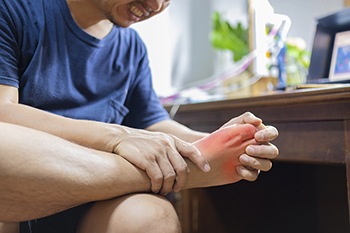
The joints in the big toe are affected with the condition that is known as gout. This painful arthritic condition happens as a result of excess uric acid in the blood. This can be caused by genetic reasons or from eating foods that are high in purines. These types of foods include shellfish, red meat, and drinks that are made with large amounts of sugar. Gout attacks generally begin at night and may last for several weeks. This condition can be managed when lifestyle changes are implemented, such as replacing some of the foods that are eaten with healthier choices. It is beneficial to engage in a gentle exercise program on a regular basis, in addition to drinking plenty of water daily. People who are overweight may be prone to developing gout, and additional weight may be lost when they limit the type of, and amount of, foods that are eaten. If you have had one or frequent gout attacks, it is strongly suggested that a podiatrist is contacted who can help you to manage, and possibly prevent, this uncomfortable condition.
Gout is a foot condition that requires certain treatment and care. If you are seeking treatment, contact one of our podiatrists from Carolina Foot & Ankle Specialists. Our doctors will treat your foot and ankle needs.
What Is Gout?
Gout is a type of arthritis caused by a buildup of uric acid in the bloodstream. It often develops in the foot, especially the big toe area, although it can manifest in other parts of the body as well. Gout can make walking and standing very painful and is especially common in diabetics and the obese.
People typically get gout because of a poor diet. Genetic predisposition is also a factor. The children of parents who have had gout frequently have a chance of developing it themselves.
Gout can easily be identified by redness and inflammation of the big toe and the surrounding areas of the foot. Other symptoms include extreme fatigue, joint pain, and running high fevers. Sometimes corticosteroid drugs can be prescribed to treat gout, but the best way to combat this disease is to get more exercise and eat a better diet.
If you have any questions please feel free to contact our offices located in Mount Pleasant and Charleston, SC . We offer the newest diagnostic and treatment technologies for all your foot and ankle needs.











